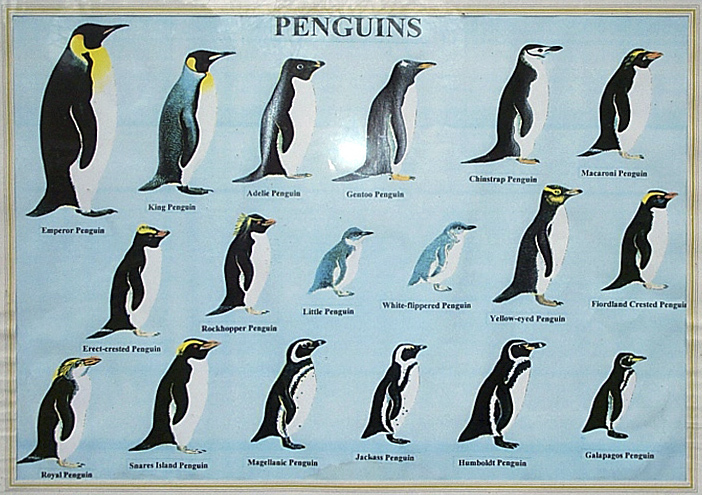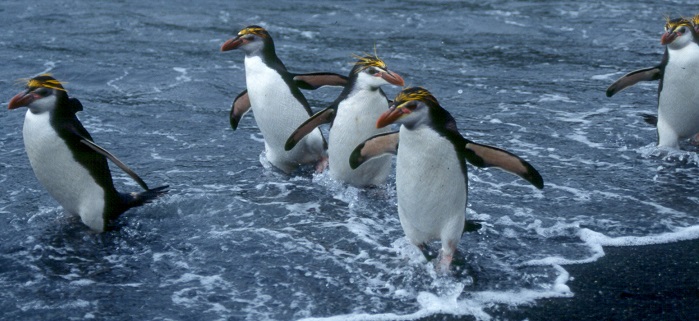Interesting Facts
There is still much to learn about the
Eudyptes schlegeli, but from what we do know, it is clear that the
Royal Penguin is a very interesting and unique species. The
bright yellow feathers atop of their heads captivate the
attention and bring smiles to the faces of most people who lay
eyes on them. This is just one of the many fascinating
characteristics that this species exhibits. These bright
feathers are not solely unique to
Eudyptes schlegeli.
Royal Penguins belong to a group of several species of penguins
which share this characteristic (see
classification page). This group of penguins is
referred to as the crested penguin and makes up the genus
Eudypyes.
Also included in this
genus are the Erect-Crested Penguin
(Eudyptes
sclateri),
Macaroni Penguin (Eudyptes
chrysolophus), Snares Penguin (Eudyptes
robustus), Fiordland Penguin (Eudyptes
pachyrhynchus), as well as the Rockhopper Penguin (Eudyptes
chrysocome). Royal Penguins, along with Macaroni Penguins,
are the largest species of the crested penguin genus;
Eudypyes. In fact
until recently, the Royal Penguin was thought to be a subspecies
of the Macaroni Penguin. Royal Penguins have even been known to
interbreed with Macaroni penguins (Murphy, 2012.) (see
reproduction). This is happens on very rare occasions.
Other species of penguins have been known to infrequently
interbreed. There are two notable differences between
Eudyptes schlegeli and
Eudyptes chrysolophus. One is that the Royal Penguin has a
white face and chin, while the Macaroni Penguin has a black face
and chin. The other difference between these fairly similar
species is that the Royal Penguin is known to only breed at one
location, Macquarie Island. The Royal Penguin is the only
species known to inhabit this island, and it is not known as to
why they are the only species to inhabit this island. Macquarie
Island is an island that lies in the southwestern Pacific Ocean,
about halfway between New Zealand and the frigid continent of
Antarctica.
Royal Penguins, like other species of penguins, are
a colonial species. This means that instead of living solely in
monogamous pairs, Royal Penguins exist in colonies which generally stick
 together. There has been an interesting finding pertaining to the
different colonies inhabiting this island. The diet of the penguins
seems to differ from colony to colony. This is especially particular
when contrasting the diet of colonies on the east coast of the island to
the colonies
together. There has been an interesting finding pertaining to the
different colonies inhabiting this island. The diet of the penguins
seems to differ from colony to colony. This is especially particular
when contrasting the diet of colonies on the east coast of the island to
the colonies inhabiting the west coast. Overall though, half of the
Royal Penguin’s diet consists of small deep sea fish, namely lantern
fish from the family Myctophidae. About a quarter of the diet consists
of krill and other crustaceans from the family Euphausiidae. The other
quarter consists of namely squid and other various crustaceans (Royal
penguins. 2010, August 12).
inhabiting the west coast. Overall though, half of the
Royal Penguin’s diet consists of small deep sea fish, namely lantern
fish from the family Myctophidae. About a quarter of the diet consists
of krill and other crustaceans from the family Euphausiidae. The other
quarter consists of namely squid and other various crustaceans (Royal
penguins. 2010, August 12).
The largest colony of Royal Penguins is routinely found at Hurd Point during breeding season. Hurd Point is located at the southern point of Macquarie Island (see habitat page). This colony is estimated to be made up of around 1 million Royal Penguins, which is about half of the estimated global population of roughly 1,600,000 individuals (Ellenbroek, B. 2013.)
The
discovery of this species dates back to the 1800’s and is credited to
the famous zoologist Hermann Schlegel, which is how the Royal Penguin
acquired the scientific name
Eudyptes schlegeli. The Royal Penguin, like many other species of
penguins, is a monogamous species. Before mating, male Royal Penguins
perform a vertical head swinging motion, as well as a mating call (Waas
et al. 2000).
Eudyptes schlegeli is listed as a vulnerable species on the IUCN Red List of Threatened Species, which means that the species is in danger of becoming threatened, which is the stage before endangerment and extinction (Royal Penguins, Eudyptes schlegeli , MarineBio.org). They are listed as a vulnerable species largely because the population had been seriously affected by human overhunting in the past. Historically, humans hunted the Royal Penguins in order to harvest the oil that coats their feathers. Today we have found other means of obtaining similar oils, so the Royal Penguins are no longer hunted. Tasmanian Parks and Wildlife Services have implemented regulations and restrictions which, in turn will only benefit the Royal Penguin’s population and habitat (Koehn, A. 2001.)
Since humans no longer hunt
Eudyptes schlegeli, their main predator consists of large seals.
Leopard Seals (Hydrurga leptonyx)
in particular regularly hunt
these penguins. The Leopard Seals hunt the penguins by biting the webbed
feet and thrashing and pounding them against the surface of the water.
Other predatory animals that prey on the Royal Penguin include orcas and
sea birds such as skuas, gulls and petrels (Ellenbroek, B. 2013.)


